Similar presentations:
Arabic cluster: a bridge between east and west
1. ARABIC CLUSTER: a bridge between East and West
ARABIC CLUSTER:A BRIDGE BETWEEN EAST
AND WEST
(Kabasakal H.,Bodur M.)
Aleksandre Kacharava nº 2141266
Katsiaryna Pechankova nº 2141227
Tatiana Alshevskaya nº2141234
2. CONTENTS:
Generalcharacteristic of the Cluster;
Findings
from GLOBE data: Societal practicies and
values;
Findings
from Globe data: Outstanding leadership
attributes;
Implications
Personal
for managers;
opinion.
3. Arab world (Arab nation)
ARAB WORLD (ARAB NATION)22 arabic-speaking countries (identity – Arabic language)
4. Arabic cluster
ARABIC CLUSTEREgypt
Kuwait
Morocco
Turkey
Qatar
5. Economic and DEMOGRAPHIC profile
ECONOMIC ANDDEMOGRAPHIC PROFILE
Country
Population
(millions)
GDP (U.S. $
Billion)
Human
Development
index-world
ranking
Egypt
66.7
89
105
Kuwait
1.8
30
43
Morocco
29.3
35
112
Turkey
65.7
186
82
Qatar
0.6
9
48
Arabic cluster
164.1
349
82
World
5863
3035
81
Source: Human Development Report (2000, 2001).
6. Historical foundations
HISTORICAL FOUNDATIONSThe earliest civilizations – Egypt, Anatolia, Morroco.
Egypt and Morroco were invided by Arabs in the 7th century
Egypt was conquered by Turks (16th century), French invasion (1798-1805),
Ottoman province until 1914. Then, under British Protectorate (1914-1952)
Morroco was under Spanish and French protectorates (1912 – 1956)
Kuwait – the terriotory in1500s under Portuguese control, 18th century Anaizia tribe
founded Kuwait, 1899-1914 British protectorate
Qatar – 1872-1914 under Ottoman rule, British protectorate (1916-1968)
Turkey – the Ottoman empire (1299-1923), since 1923 – republic
7. Legal systems
LEGAL SYSTEMSEgypt – mix of English common law, Napoleonic codes and Islamic law
Kuwait – civil legal system (Islamic law is important)
Morocco – mix of Islamic law, French and Spanish civil law
Qatar – Islamic law
Turkey – European civil law
8. Political systems
POLITICAL SYSTEMSEgypt - Semi-Presidential Republic
Kuwait – Constitutional monarchy
Morocco – Constitutional monarchy
Qatar – Absolute monarchy
Turkey - Parliamentary Republic
9. Religion
RELIGIONEgypt – Sunni Muslims (90%) and Coptic Christians (10%);
Kuwait – Sunni Muslims (70%) and Shi’a Muslims (30%);
Morocco – Muslims (98%);
Turkey – Muslims (99%);
Qatar – Muslims.
10. Sharia
SHARIAHygiene and purification laws (the manner of cleansing);
Economic laws (Zakāt, Waqf, the prohibition on interest or
Riba);
Dietary laws;
Theological obligations;
Criminal jurisprudence;
Military jurisprudence (Jihad, offensive and defensive; rules
regarding prisoners of war);
Dress code, including hijab;
Other topics include customs and behaviour, slavery and the
status of non-Muslims.
11. Socio-cultural elements: language
SOCIO-CULTURALELEMENTS: LANGUAGE
EGYPT, KUWAIT,
MOROCCO, QATAR
Arabic language (Afro-Asiatic
family)
TURKEY
Turkish language (Turkic
family)
12. Arab identity and ethnicity
ARAB IDENTITY AND ETHNICITYArabs are very consious about their Arab identity; language and
common culture creates a feeling of belonging to the Arab
world
Defining who is an Arab is based on the following two criteria:
Genealogical: someone who can trace his or her ancestry to
the original inhabitants of the Arabian Peninsula and the Syrian
Desert (tribes of Arabia).
Linguistic: someone whose first language, and cultural
expression is Arabic.
13. Socio-cultural elements: clothing
SOCIO-CULTURALELEMENTS: CLOTHING
14. Socio-cultural elements: food
SOCIO-CULTURALELEMENTS: FOOD
15. Values
VALUESReligion
Honor and respect
Family and network of
interdependent relations
Life
Equity in personal worth
16. Cultural dimensions
CULTURAL DIMENSIONS17. Societal practices and values
SOCIETAL PRACTICESAND VALUES
18. Societal practices and values
SOCIETAL PRACTICESAND VALUES
Group and family collectivism – HIGH (5.58)
Power distance – HIGH (5.23)
Quran and
interpretations of religion
Family & in-group
relationships
Hierarchy of relationships
Collectivistic culture
19. Societal practices and values
SOCIETAL PRACTICESAND VALUES
Future
orientation – LOW(3.58)
Concept of “fate”
Low significance of planning and influencing the future
Gender
egalitarianism – LOW (2.95)
Sex role stereotypes and inequalities
Masculine society
20. Societal practices and values
SOCIETAL PRACTICESAND VALUES
Uncertainty avoidance – MEDIUM (3.91)
Institutional collectivism – MEDIUM (4.28)
Humane orientation – MEDIUM (4.36)
Performance orientation – MEDIUM (3.90)
Assertiveness – MEDIUM (4.14)
21. Comparison among cluster
COMPARISON AMONGCLUSTER
Morocco - highest score on power distance.
Turkey and Morocco - similar results in some cultural dimensions.
Egypt – highest score on humane orientation and future orientation.
Kuwait - highest score on uncertainty avoidance.
Qatar - highest score on gender egalitarianism.
22. Comparison with other clusters
COMPARISON WITHOTHER CLUSTERS
HIGHER group and family
collectivism
HIGHER power distance
LOWER gender egalitarianism
LOWER uncertainty avoidance
LOWER future orientation
LOWER assertiveness
Cultural
dimension
Contrast with other clusters
Uncertainty
avoidance
- 0.412
Future
orientation
- 0.369
Power distance
0.118
Institutional
collectivism
- 0.034
Humane
orientation
0.281
Performance
orientation
Group and
family
collectivism
- 0.245
0.616
Gender
egalitarianism
- 0.447
Assertiveness
0.026
23. Leadership attributes
LEADERSHIPATTRIBUTES
24. Leadership attributes
LEADERSHIPATTRIBUTES
• Team-oriented – HIGH (5.47)
• Charismatic – HIGH (5.35)
25. Leadership attributes
LEADERSHIP ATTRIBUTES• Team-oriented – HIGH Influence (5.47)
Group-oriented & team-builders
Collaborative, loyal, consultative
Diplomatic, intra-group conflict avoiders,
win-win problem-solvers
• Charismatic – HIGH influence (5.35)
Visionary & future oriented
Inspirational, positive, enthusiastic,
motivational, confidence builders
Risk takers & self-sacrificial
Decisive, logical
26. Leadership attributes
LEADERSHIP ATTRIBUTES• Participative
Non-autocratic & non-dictatorial manner
Delegate tasks
SLIGHT Influence (4.98)
• Humane
Generous & compassionate in a modest
and patient manner
SLIGHT Influence (4.80)
27. Leadership attributes
LEADERSHIP ATTRIBUTES• Self-protective
Self-centered, status conscious,
conflict inducer
NEGATIVE Influence (3.79)
• Autonomous
Individualistic, independent,
autonomous and unique
NEGATIVE Influence (3.69)
28. LeadeR
LEADERsets a vision and promotes performanceorientation in a collectivistic manner
Initiates change and improvement by
keeping group solidarity and avoiding
nepotism
29. Leadership attributes: differences among cluster
LEADERSHIP ATTRIBUTES:DIFFERENCES AMONG
CLUSTER
Kuwait, Turkey and Egypt – team-oriented and charismatic
Morocco and Qatar - participative and team-oriented
30. Comparison with other clusters
COMPARISON WITHOTHER CLUSTERS
Have
modest style, not stick out, keep
group solidarity
Be
a man with a “miracle”, who leads
followers to ideals, initiate change and
improvement
31. Implications for managers
IMPLICATIONSFOR MANAGERS
Develop personal relationships and group solidarity;
Build trust;
Employ traditional approaches and promote practices and values
needed for competition (dual set of values);
Leader can evaluate subordinates, but he is responsible for their
well-being;
Unacceptable for subordinates to evaluate the leader;
Use “Consultation” and “Third party” conflict resolution.
32. PERSONAL OPINION
Not perfect distribution of countries among clusters (Turkeyis very different from Arab countries in many aspects);
It seems that country of origin of the authors influenced the
attention paid to their country.
Obtained results and further implications for managers can
be useful for managerial practices in the analyzed countries
and future studies.




















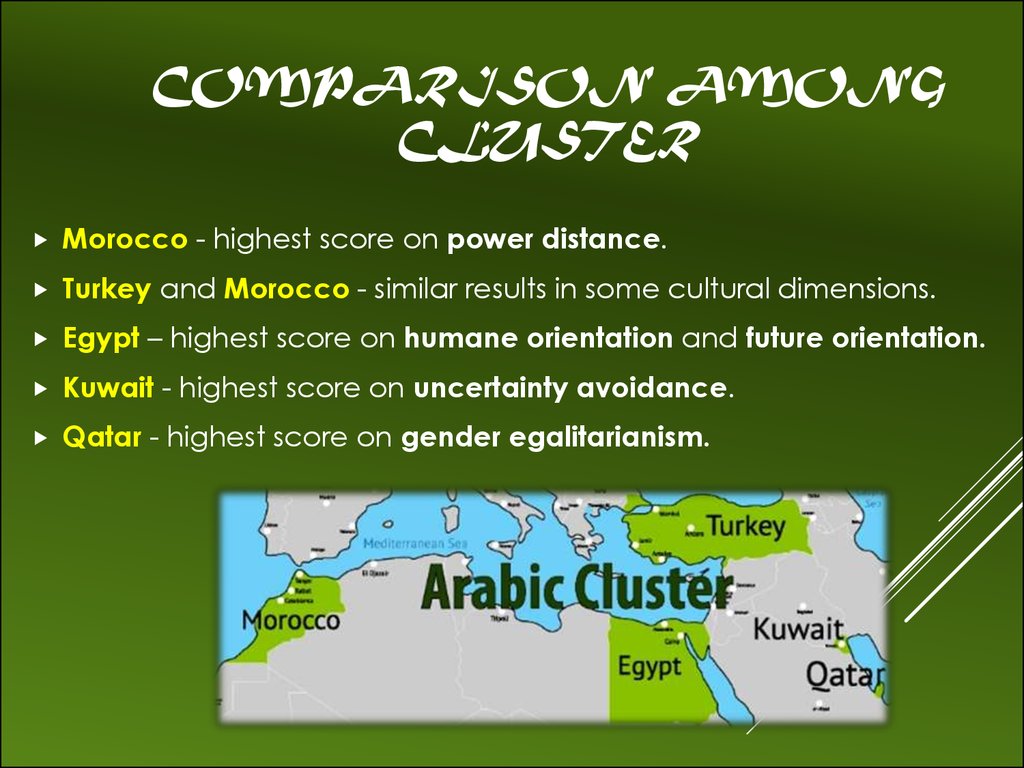
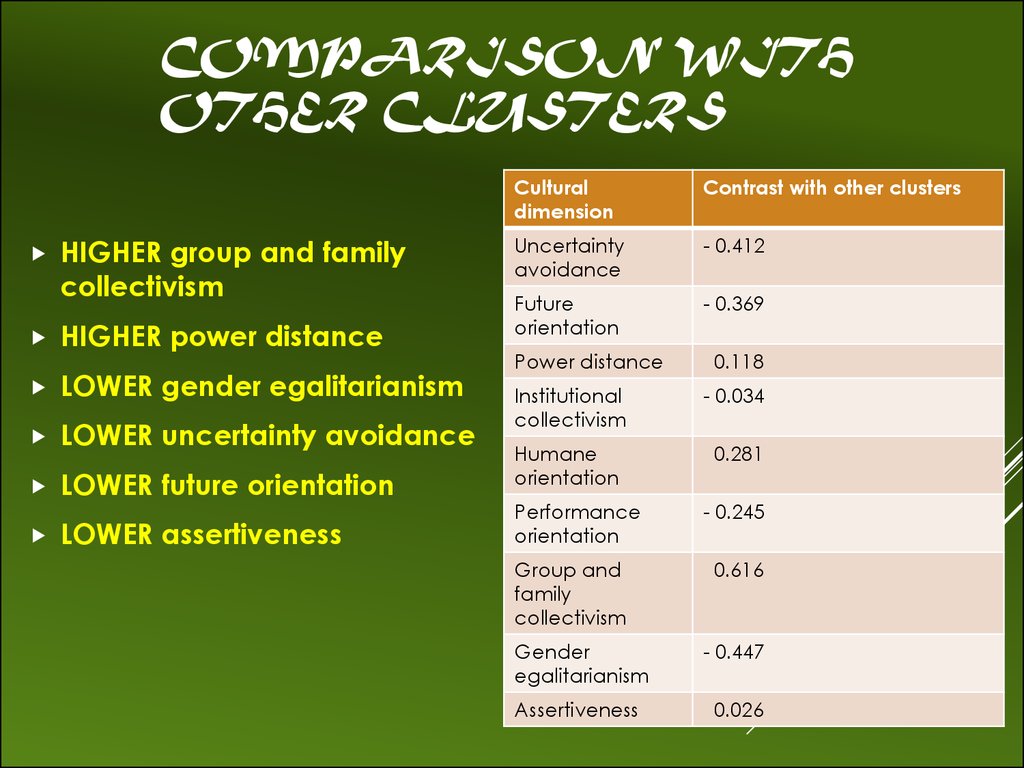


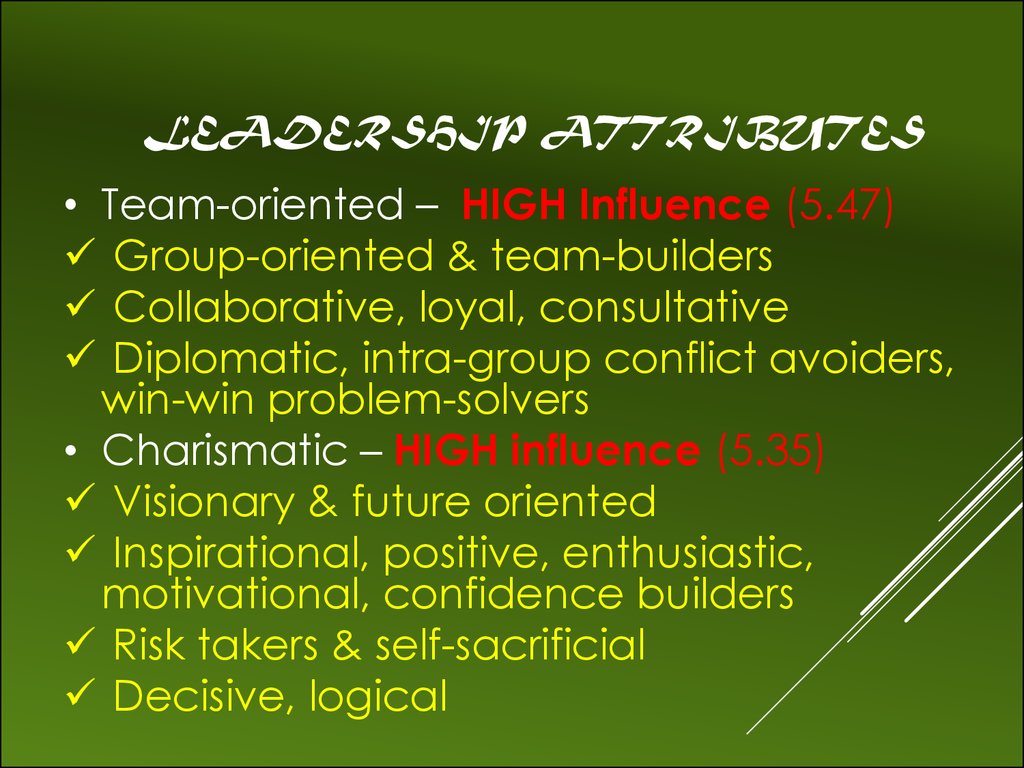
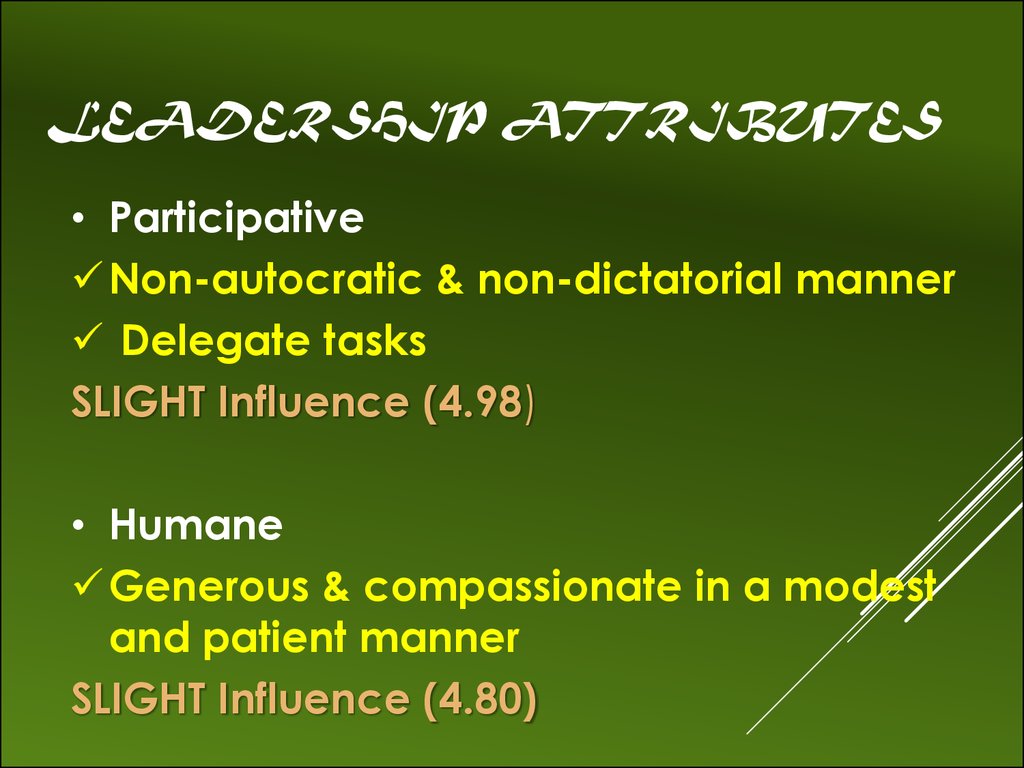
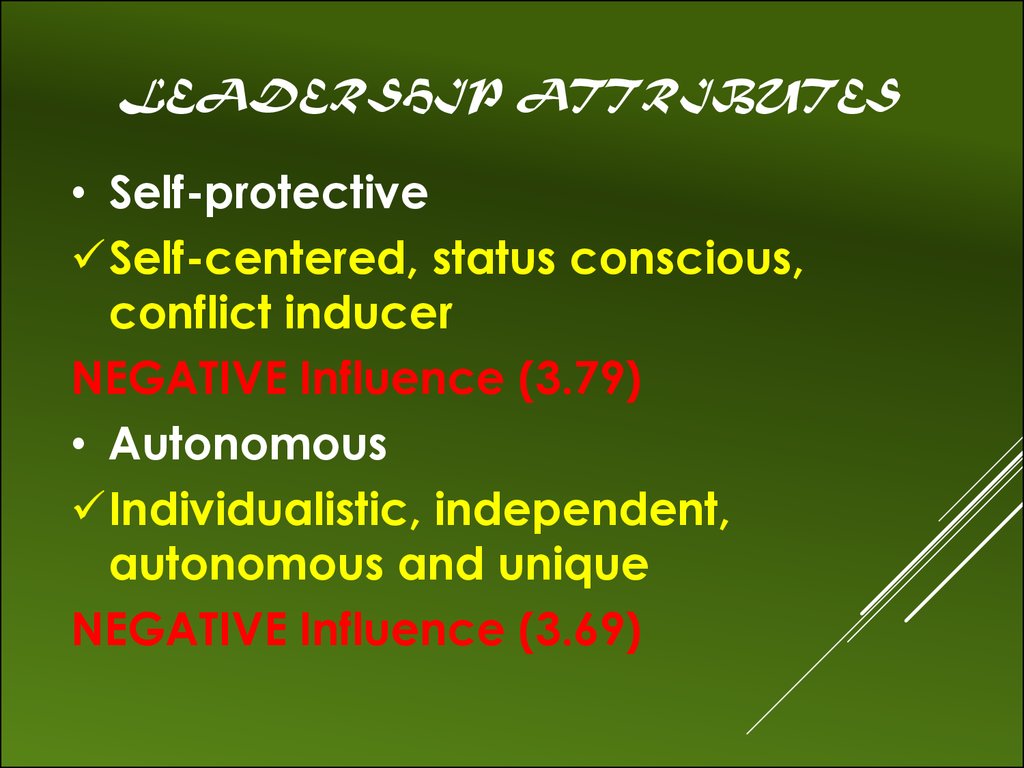

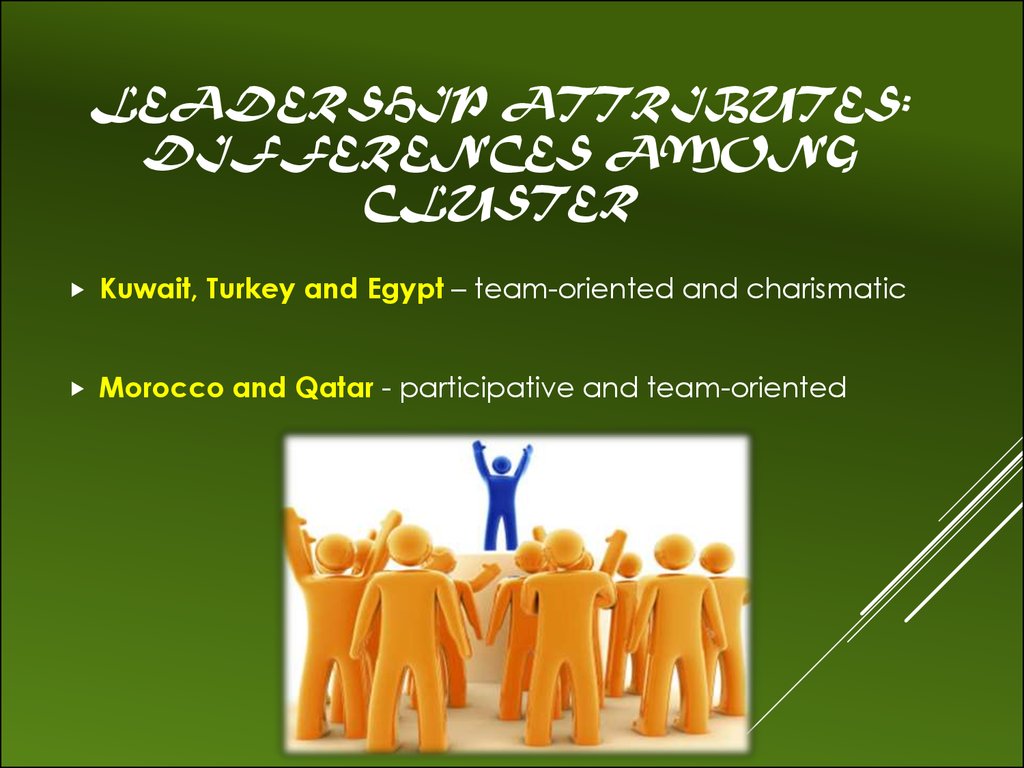
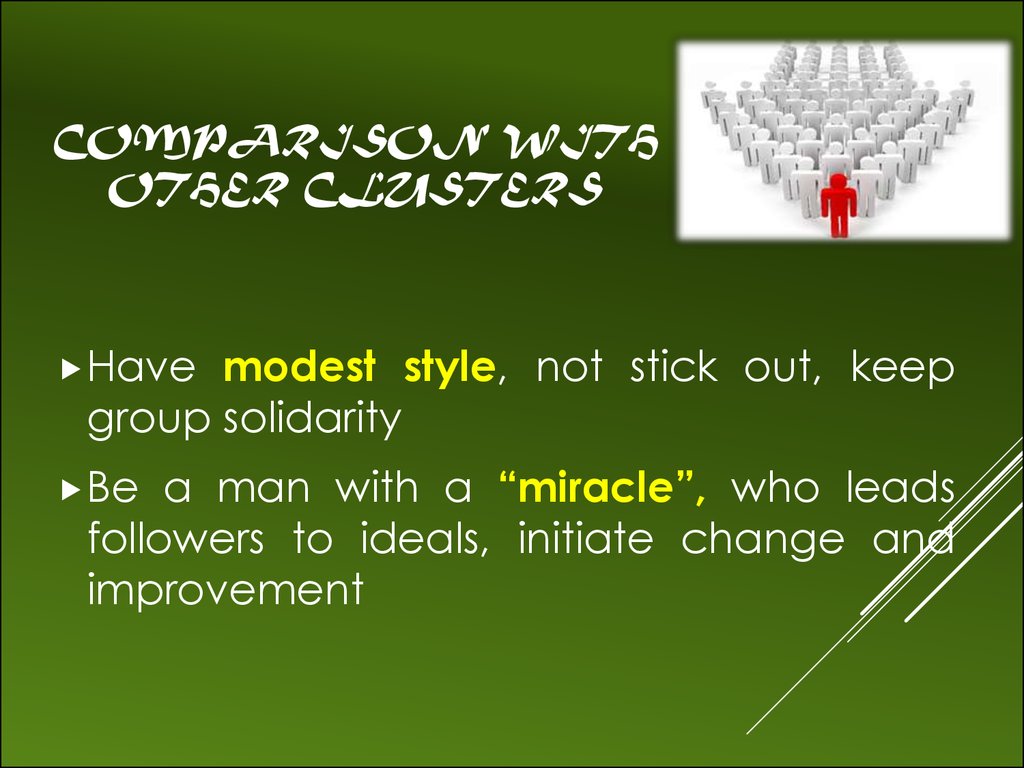
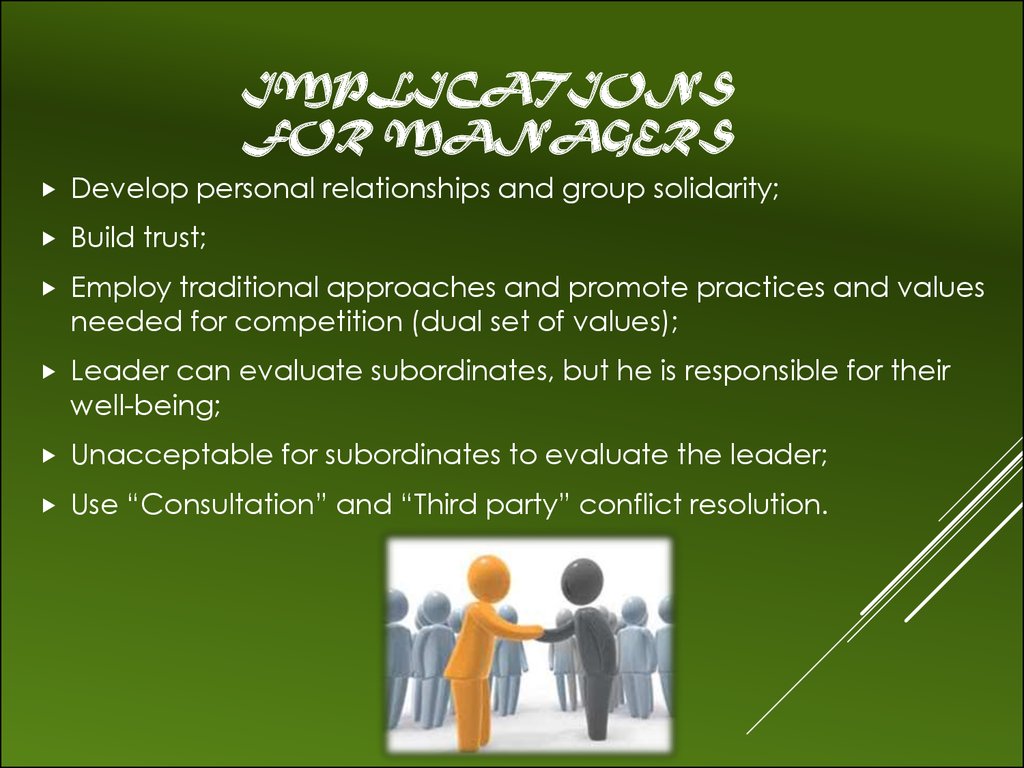
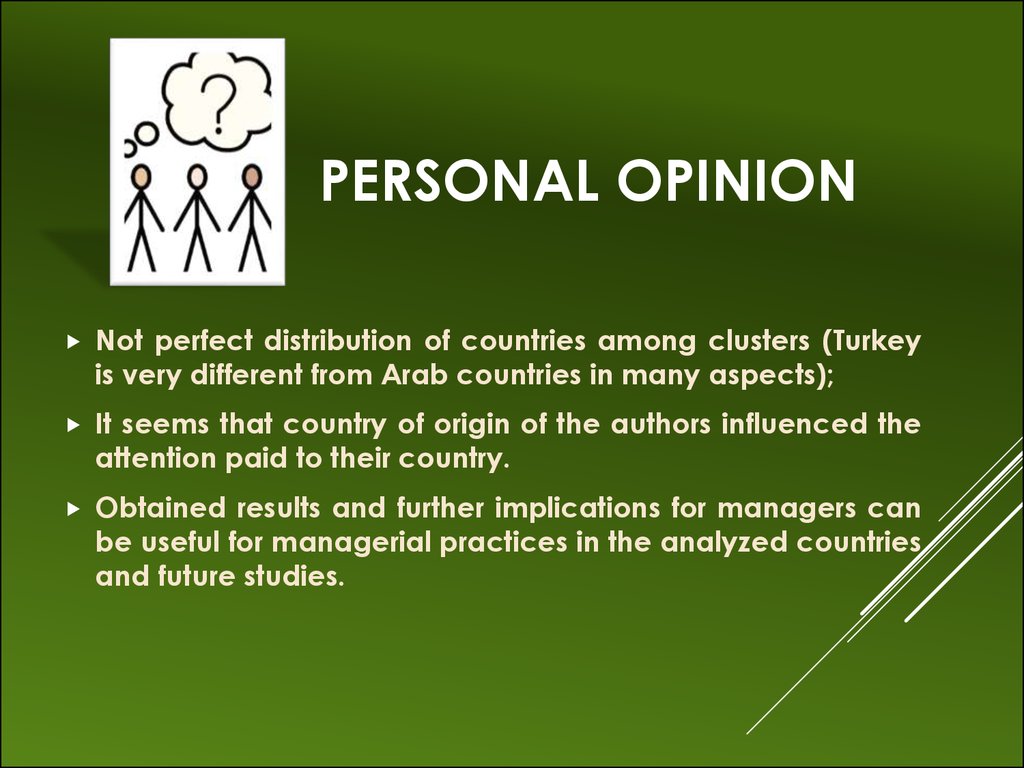
 policy
policy english
english








